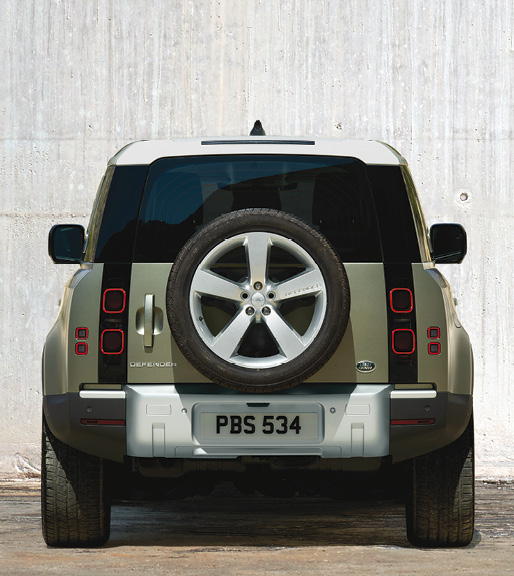WORDS Russ Atkinson
It’s the long-awaited, potentially doomed to be unpopular, unanticipated yet anticipated replacement for what has become an undisputably global icon – the culmination of 71 years of development – and possibly the biggest story in the automotive world of late. But is it any good?
Sorry to disappoint, but I can’t even begin to form an opinion on that, unfortunately, because hardly anybody has driven one yet and my invitation to the launch at the Frankfurt Motor Show must’ve become lost in the post.
Relying solely on Land Rover’s press pack would be a foolish basis for an editorial piece, so I’m going to mix in a bit of original conjecture for good measure, based on the almost endless stream of photographs that’ve recently filled my Instagram feed, giving my thumb an RSI scrolling through them to get back to the usual selection of classic Porsches, motorbikes, Brutalist architecture and Russian dashcam videos. Reading the comments – which is admittedly a dangerous pastime – it seems that opinions are polarised.
Is anybody surprised to read this? I doubt it.
Replacing such a globally-lauded, unimitable, utilitarian, uncomfortable, unaerodynamic, uncomplicated and unmistakable design icon with a vehicle that conforms to post-1980s safety standards and shares some of its siblings’ technological advancements was never going to be an easy task, and I get the feeling that Land Rover always knew that no matter what they presented as a replacement for the ubiquitous Defender, there’d be naysayers.
Being change-averse is a terribly British pastime, after all. Take Brexit, for example; where the people who voted for it were likely to be feeling averse to the changes made in 1973 – long before even the predecessor to the original Defender, the Land Rover Ninety and One Ten even existed. Ironically, it also happens to be European crash regulations that have prompted the ground-up redesign that you see here.
I’ll be honest, my first impression is that it looks like a great replacement… for the Freelander. It’s got that child’s toy aesthetic, which I think is cool, but from the outside, at least, the cabin looks low. It also seems that it has a wider track than the original Defender, as well as being heavier across the range, so on paper things don’t seem ideal. Before we plunge too far down into the rabbit-hole of negativity, and as an unashamed fan of rust-ravaged terrible, antiquated British vehicles, it’s important to remember three things:
Firstly, people probably felt exactly the same way in 1983 when they unveiled the Ninety and One Ten range, predecessors to the Defender, which strutted onto the scene in 1990 modelling the Emperor’s finest new clothes. Coil springs, you say? A wider track? Plastic wheelarches?! Even the addition of wind-up windows probably did just that to more than a few steadfast Series Landie owners. Yes, the same people who lambasted the Series 3’s plastic grille because it could no longer be removed and repurposed as a barbecue grill when required. Plastic? How very dare they.
Secondly, despite how universally adored the original Defender was, is, and will continue to be, on the whole they are actually quite crap. They leak, they corrode at a rate that is genuinely impressive, they’re agricultural, sketchy in high wind, leave absolutely no room for your right elbow when the window is up and the 110 and longer wheelbase versions have the turning circle of the Emma Maersk. I learnt this first hand, because my first proper car was a Ninety V8 – and I bloody loved it. Despite their foibles, they’re easy to adore, but that isn’t really grounds for continuing to produce a product that isn’t really fit for task. Unless that task is being dropped out of a C130 and advancing into a warzone. And even then, you’d better hope it doesn’t break down on the way. Td5 and Puma engines, I’m looking at you.
Thirdly, Land Rover surely won’t have dropped the ball with this one, given there are a lot of people primed and ready to say that they saw it coming if their new offering falls short of the mark. Is the 2020 Defender Land Rover’s answer to the Toyota Landcruiser; combining phenomenal off-road capability with modern creature comforts and bulletproof reliability? Time will tell, but I’ve a feeling it has the potential for it.
If you’re still in doubt, there’s something that you need to be aware of. Something that might just compensate for any areas in which you feel the new Defender might be lacking: you can ask for one with a 400bhp, 3 litre straight-six. That’ll do pig, that’ll do.
Admittedly, that engine option is actually a ‘mild hybrid’ that uses an electronic supercharger, and it also apears that there will be no manual gearbox option across the entire range, but let’s remember that it isn’t 1983 and nobody really ever liked vinyl seats anyway, even if they do hose down quite nicely, which can be convenient.
Land Rover claim that it’s the ‘most capable Land Rover ever made’ – that’s straight out of the press pack – and having read said press pack, I’m inclined to believe it, too. It sounds like everything I ever wanted my Ninety to be, but I bet it doesn’t sound half as good. I’m excited to drive one.




